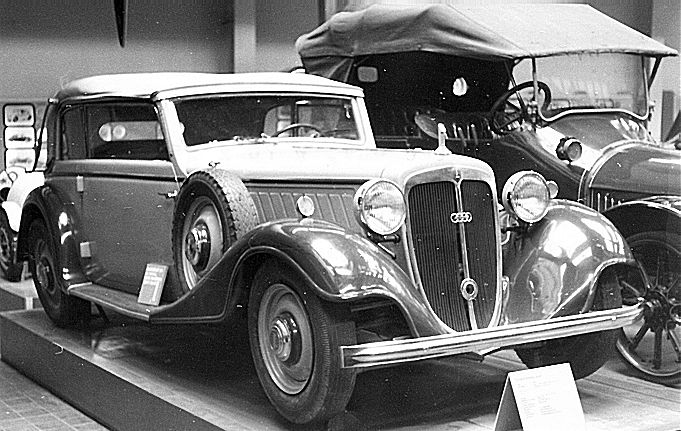The Audi Front UW stands as a testament to automotive innovation during the interwar period. This remarkable vehicle emerged from the collaborative genius of four prestigious German automakers under the Auto Union banner. Its groundbreaking design challenged conventional engineering wisdom and set new standards for luxury car manufacturing in Europe.
The dawn of the 1930s marked a pivotal moment in automotive history. As economic pressures pushed manufacturers toward consolidation, the merger that created Auto Union sparked an unprecedented wave of innovation. The Front UW became the physical embodiment of this creative renaissance, combining luxury with cutting-edge engineering.
Revolutionary Engineering for Its Time
The Front UW’s engineering prowess centered on its revolutionary drivetrain configuration. The integration of a six-cylinder engine with front-wheel drive marked a significant departure from contemporary design philosophy. Engineers achieved an impressive balance between power delivery and handling characteristics, setting new benchmarks for automotive performance.
The model offered two distinct engine variants: the UW 220 with its 2.0-liter powerplant and the more potent UW 225 featuring a 2.25-liter engine. Both versions demonstrated remarkable engineering refinement, delivering smooth power delivery and impressive torque characteristics for their era.
“The Front UW’s drivetrain configuration was years ahead of its time. Its influence on automotive design philosophy cannot be overstated,” notes Dr. Heinrich Mueller, Classic Audi Restoration Specialist.
Fact!
The UW 225 variant produced 54 horsepower at 3300 RPM - a significant output for a luxury car of the 1930s, especially considering its innovative front-wheel-drive configuration.
The four-speed manual transmission, though conventional by today’s standards, represented a masterpiece of precision engineering for its time. Its smooth operation and durability contributed significantly to the car’s reputation for reliability.
Design Philosophy and Manufacturing
The Front UW’s production at the Horch factory exemplified the benefits of industrial consolidation under Auto Union. The manufacturing process incorporated innovative “smart group technology,” streamlining production while maintaining exceptional build quality.
Designers offered the Front UW in two distinct body styles, each targeting different market segments:
- two-door convertible by Gläser featuring elegant proportions and refined detailing;
- stately limousine variant emphasizing comfort and presence;
- custom coachwork options for discerning clients;
- aerodynamic considerations in body design for improved performance;
- premium materials throughout the interior and exterior.
Historical Reference!
The Horch factory's production methods for the Front UW introduced several manufacturing innovations that would later become industry standards, including modular assembly techniques and standardized quality control processes.
“Each surviving Front UW tells a story of meticulous craftsmanship and engineering excellence,” remarks Marcus Schmidt, Vintage Auto Curator at the German Technical Museum.
The attention to detail extended beyond mere aesthetics. Each component underwent rigorous testing and refinement, ensuring both reliability and performance met the exacting standards expected of a premium automobile.
Legacy and Historical Impact
The Front UW’s influence extends far beyond its production run from 1933 to 1938. Its innovative drivetrain configuration proved prescient, as front-wheel drive later became the dominant layout for passenger cars worldwide.
The technical achievements of the Front UW laid groundwork for future innovations in automotive design. Its success demonstrated the viability of complex engineering solutions in premium vehicles, encouraging further development across the industry.
Important!
One of the surviving Front UW models discovered in Russia during World War II provides valuable insights into the car's durability and engineering quality, having survived decades of challenging conditions.
The merger that created Auto Union, and subsequently led to the Front UW’s development, exemplified successful industrial collaboration. This partnership model would influence corporate strategies throughout the automotive industry for decades to come.
Modern Perspective
From today’s vantage point, the Front UW represents a crucial evolutionary step in automotive development. Its innovative features, once revolutionary, have become standard elements in modern vehicle design.
Contemporary automotive engineers continue to draw inspiration from the Front UW’s solutions to technical challenges. The integration of powerful engines with front-wheel drive remains a fundamental consideration in vehicle development.
The Front UW’s value in the classic car market reflects its historical significance. Surviving examples command premium prices at auctions, while restoration projects attract dedicated enthusiasts seeking to preserve this important piece of automotive heritage.
Restoration specialists face unique challenges when working with the Front UW, often requiring custom fabrication of components. This process helps preserve traditional craftsmanship skills while ensuring these historic vehicles remain operational for future generations.
Looking Forward — The Enduring Influence
The Audi Front UW’s legacy lives on in every front-wheel-drive luxury car produced today. Its pioneering spirit continues to inspire automotive engineers and designers, demonstrating how revolutionary thinking can shape industry standards for generations.
The principles of innovation and engineering excellence embodied by the Front UW remain central to Audi’s brand identity. This historical connection provides valuable context for understanding the evolution of automotive technology and the enduring impact of groundbreaking design.
Pros & Cons
| Advantages | Disadvantages |
|---|---|
| Revolutionary front-wheel-drive system providing improved traction and handling | Higher production costs due to complex engineering solutions |
| Powerful and refined six-cylinder engine options delivering smooth performance | Limited production numbers resulting in scarcity of parts today |
| Advanced manufacturing techniques ensuring high build quality | Heavier front end compared to contemporary rear-wheel-drive vehicles |
| Elegant body designs available in multiple configurations | Complex restoration process requiring specialized knowledge |
| Innovative “smart group technology” improving production efficiency | Higher fuel consumption compared to smaller engines of the era |
| Historical significance as a pioneering luxury vehicle | Limited availability of technical documentation for restoration |
| Robust construction contributing to long-term durability | Challenging maintenance due to unique drivetrain configuration |
The Audi Front UW represents a perfect synthesis of innovation and craftsmanship. While its complex engineering presents challenges for modern restoration, these same characteristics make it an invaluable piece of automotive history. Its influence on vehicle design and manufacturing processes continues to resonate through the automotive industry, making it a true pioneer in the evolution of the automobile.

